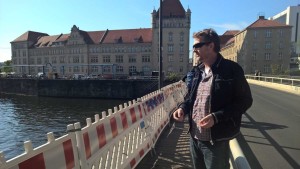
“In the late ’80s,” locations manager Klaus Darrelmann told me as I piled into his Mini-Cooper on a recent Sunday morning, “Berlin wasn’t on the map.” Of course, in the late ’80s, half of Berlin wasn’t on the map either – at least, not on one accessible to Western filmmakers, since the city was still divided into Western and Eastern blocs.
Only a small handful of German filmmakers were calling the city home then, notably Rainer Werner Fassbinder and Wim Wenders, part of a scene that was “more punk,” as Darrelmann explained it, in part because things were cheap. American and British movies generally only came to Berlin if its grey post-war skylines and industrial zones were specific to the plot, like the mid-’60s Michael Caine spy opus, Funeral in Berlin.
But all that changed when the Wall came down in in 1989. By then, Fassbinder’s star, having burned brightly as part of a German new wave film scene, had already flamed out. Wim Wenders is still there, now working out of his fashionable Mitte district storefront offices, a gentrifying district that was once on the East side of the divide. But big studio productions have come calling as well, and not only for projects, like the recent Bourne films, that have Berlin-specific settings.
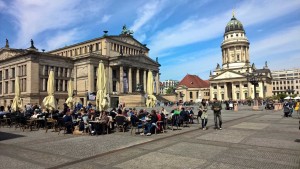 But whether the setting is for spy fare, historical epics, or fantasy films, in Germany’s reunited, redeveloping capital Darrelmann is known as something of a magician in terms of finding locales, for a wide array of movies. He’s worked everything from Steven Spielberg’s upcoming Bridge of Spies, to Mission Impossible: III, the multi-chaptered Cloud Atlas, Inglorious Basterds, the Liam Neeson thriller Unknown, as well as Hansel & Gretel: Witch Hunters and the two-part Mockingjay finale to the Hunger Games trilogy. The city’s dressability lends itself to both fantasy films and dystopian ones in addition to thrillers or sometimes stories combining both.
But whether the setting is for spy fare, historical epics, or fantasy films, in Germany’s reunited, redeveloping capital Darrelmann is known as something of a magician in terms of finding locales, for a wide array of movies. He’s worked everything from Steven Spielberg’s upcoming Bridge of Spies, to Mission Impossible: III, the multi-chaptered Cloud Atlas, Inglorious Basterds, the Liam Neeson thriller Unknown, as well as Hansel & Gretel: Witch Hunters and the two-part Mockingjay finale to the Hunger Games trilogy. The city’s dressability lends itself to both fantasy films and dystopian ones in addition to thrillers or sometimes stories combining both.
One such combination was The Grand Budapest Hotel, Wes Anderson’s critically lauded film, which also nabbed a production design Oscar for Adam Stockhausen and set decorator Anna Pinnock. Set in the fictional republic of Zubrowka in an alternate, yet familiar, timeline between World Wars, it was no accident that Darrelmann won an award for the same film, from the Locations Managers Guild, for outstanding locations in a period film.
Much of that outstanding location was in a nearby city of the former GDR, or German Democratic Republic, called Görlitz, specifically in an “unused department store, built in 1912. The company owning it went bankrupt six or seven years ago. Since then, the building hasn’t been used for anything. It was looking kind of cheesy inside, with additions from GDR, which always ruin the whole building.”
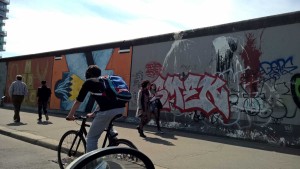 But that cheesy building struck Anderson as something that could be turned into pink-hued gold. Producer Jeremy Dawson had called Darrelmann to set up a tour, which was designed to take in most of Germany. “We laid out a complete route, from Hamburg to Bavaria. It’s fascinating to scout with Wes, because he’s not really interested in following a certain laid out plan, it’s more like veering off track – ‘that looks like an interesting city!’ – and you take off from the motorway and have a look at it. Which usually doesn’t get you anywhere.”
But that cheesy building struck Anderson as something that could be turned into pink-hued gold. Producer Jeremy Dawson had called Darrelmann to set up a tour, which was designed to take in most of Germany. “We laid out a complete route, from Hamburg to Bavaria. It’s fascinating to scout with Wes, because he’s not really interested in following a certain laid out plan, it’s more like veering off track – ‘that looks like an interesting city!’ – and you take off from the motorway and have a look at it. Which usually doesn’t get you anywhere.”
But in this case, once it got them to Görlitz, the director knew he’d found his own private Zubrowka. Seeing the derelict store’s “giant courtyard, with a glass roof, Wes couldn’t go past that. That was like the ideal thing to put in a big, big hotel lobby – even bigger than real life.”
That four stories lobby allowed for some great depth-of-field shots, like star Ralph Fiennes running from the police, deep into frame, in a protracted single take. The large building also allowed for there to be production offices in the top floor, and prop storage and shops in the basement.
But getting permission to use the building required some tricky negotiations, since the bankruptcy meant it was under forced management. “There was a Dutch lawyer taking care of it. It was quite a pain.” But he eventually, nimbly, negotiated that pain, which is another thing that production companies have grown to rely on him for.
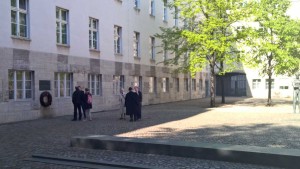 He also had to negotiate to use the German equivalent of a “Pentagon courtyard,” for the Tom Cruise film Valkyrie, where the actor played Col. Claus von Stauffenberg, who attempted to assassinate Hitler and bring an early end to the war by placing a bomb in the conference room of the Wolf’s Lair.
He also had to negotiate to use the German equivalent of a “Pentagon courtyard,” for the Tom Cruise film Valkyrie, where the actor played Col. Claus von Stauffenberg, who attempted to assassinate Hitler and bring an early end to the war by placing a bomb in the conference room of the Wolf’s Lair.
The assassination failed, of course, and von Stauffenberg and his co-plotters were all executed in the courtyard of German defense headquarters. Surprisingly, the building is still headquarters for their Defense Dept., but they only lease space, and aren’t the only the tenants there. It was also surprising how accessible that same courtyard – three-quarters of a century later – is on a Sunday morning. In fact access around the capital is much easier than it would be in Washington, D.C.
We parked the Mini and walk up to a wall in the courtyard marked by a brass wreath, noting the executions that took place there. When Cruise and director Bryan Singer wanted to use that same spot “all hell broke loose. Everyone speculating whether it would be a good idea to have us shoot here or not.” The back-and-forth “took a week or two weeks, but finally we ended up shooting here.”
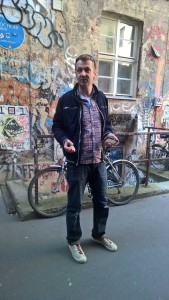 The government eventually relented because the film was in fact about von Stauffenberg, and wasn’t being used for a fictionalized war drama. Darrelmann recounts Cruise, and co-writer Christopher McQuarrie, giving touching speeches to the cast and crew before the executions were re-enacted and filmed. And of course, with permission to use what has become a historically significant site “only once,” the film shot that night became damaged after the scene was wrapped. Darrelmann had to then negotiate to come back again, a week later. “It was quite painful, but it worked out finally.”
The government eventually relented because the film was in fact about von Stauffenberg, and wasn’t being used for a fictionalized war drama. Darrelmann recounts Cruise, and co-writer Christopher McQuarrie, giving touching speeches to the cast and crew before the executions were re-enacted and filmed. And of course, with permission to use what has become a historically significant site “only once,” the film shot that night became damaged after the scene was wrapped. Darrelmann had to then negotiate to come back again, a week later. “It was quite painful, but it worked out finally.”
It also worked out, more recently, for Bridge of Spies, Spielberg’s upcoming Cold War drama about downed U2 pilot Gary Powers. The director wanted to use the actual Glienicke Bridge, outside Berlin en route to Potsdam, where the U.S. and USSR used to face each other, over opposite banks of the Havel River. Powers was eventually exchanged there for released Soviet spies, and the noted director wanted to film his recreation of that tradeoff on the exact same bridge. The government, predictably, initially, balked. But in the end, because the film was in fact recreating one of the historical events the bridge is noted for, they agreed, as they had earlier with the courtyard for Valkyrie.
Darrelmann was impressed with Spielberg’s well-oiled production machine: “He sticks to his plan, without limiting his options. He has a fantastic first A.D (Adam Somner), and a fantastic director of photography (Janusz Kaminski) and they’ve worked for ages with him.” The director was able to use a kind of shorthand with his long-time collaborators, so when a shot would be set-up – on Glienicke Bridge, or elsewhere – “everything as Kaminski described it was exactly what happened.”
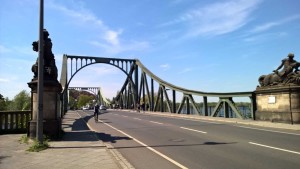 Such a smooth operation doubtless helped the American production fit into European working hours and rules. Contrasted to stateside productions, and their employees who essentially rely on overtime wages, as Darrelmann recounts, in Germany “only certain positions would get extra hours – the technical departments. The other ones usually go on a flat rate.” As he explained that for each hour of overtime, there’d be an additional hour off. “That was a regulation that no one took so much care of… but then, smaller accidents happened, nothing major, but we’d get health insurance asking questions, ‘you’d work 13 hours, and then you had an accident?’” When the creeping overtime started to cause small accidents, there was a general course correction in overtime hours, so that big accidents – like those we’ve had in America – wouldn’t occur. “Now people are following these rules more and more, so you’re not doing these crazy hours anymore.”
Such a smooth operation doubtless helped the American production fit into European working hours and rules. Contrasted to stateside productions, and their employees who essentially rely on overtime wages, as Darrelmann recounts, in Germany “only certain positions would get extra hours – the technical departments. The other ones usually go on a flat rate.” As he explained that for each hour of overtime, there’d be an additional hour off. “That was a regulation that no one took so much care of… but then, smaller accidents happened, nothing major, but we’d get health insurance asking questions, ‘you’d work 13 hours, and then you had an accident?’” When the creeping overtime started to cause small accidents, there was a general course correction in overtime hours, so that big accidents – like those we’ve had in America – wouldn’t occur. “Now people are following these rules more and more, so you’re not doing these crazy hours anymore.”
As for his adopted city of Berlin, and all the nooks, crannies, and rough edges he has come to love, and brought Hollywood to love, Darrelmann said, “People are moving here, the city is evolving, how can you stop that?”
You can’t, of course. You just need the right tour guide to help you navigate it all.





